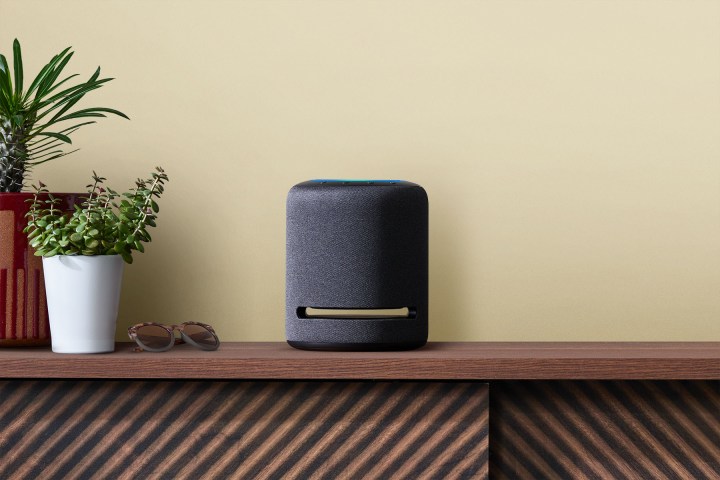With the right speaker, you can easily make Amazon’s Alexa voice assistant a part of your home theater setup, a great choice for streaming high-quality music playback! Here’s everything you need to get started, and how to link up Alexa the right way.
Step 1: Find an Alexa-compatible speaker

Your first step is to find a speaker that you connect to using Alexa. If you already have a Bluetooth speaker setup that you like, just double-check that it’s compatible with Alexa. Fortunately, this is an increasingly common feature to add to the latest TV soundbars and similar home theater speakers, so it shouldn’t be hard to find the right device for your entertainment system. When in doubt, you can visit Amazon’s list of speakers compatible with Echo devices to get started.
Note: If you have a larger home theater with multiple speakers involved, it may be a better idea to look for a receiver that’s compatible with Alexa or Echos instead. These Alexa receivers also exist, although they aren’t as well known as speakers, and they are an ideal solution for surround sound setups. Most of our other steps will remain the same with a compatible receiver.
Step 2: Choose a device that has Alexa built in

While many speakers have Alexa compatibility for connection to Amazon’s voice assistant, you also need a device that Alexa can listen through, and not many home theater speakers offer this capability. That means you need a device with Alexa built in for easy commands, and Amazon’s own Echo devices are the best place to start.
What Echo device works best for you will depend on your plans, but the latest Echo 4th-gen is a great model, and the Echo Show comes with a touchscreen display for more bonus features. Again, if you already have an Echo or a device with Alexa in it, you don’t have to worry about this step. You can also choose to talk to Alexa directly from your mobile device, although this can be a bit more awkward when operating your home theater.
Step 3: Download the Alexa app and set up an account

If this is your first time using an Alexa device, you will need to take time to download the Alexa app, available on both iOS and Android, and sign in to set up your account. You can sign in with your Amazon ID if you already have one. Once Alexa is ready to connect with other smart devices in your home, you are set.
We also suggest using Alexa’s services to connect to your favored music streaming services at this point. Alexa is compatible with Spotify, Pandora, Deezer, iHeartRadio, SiriusXM, and more. Since playing music over your entertainment system is one of the best ways to use Alexa when you are finished, it’s a good idea to have this step already completed when you are ready. You will need your streaming service logins for this step: Check out our other tips on setting up Alexa, too!
Note: Some devices may have you use a third-party app to set up the speaker and connect to Alexa (some Sony speakers, for example, may have you use the Music Center app). Generally, do what your speaker manual recommends.
Step 4: Pair the new speaker with Alexa

Check that your speaker is on and ready. Open your Alexa app, and select More on the bottom right menu. Then select Add a Device to begin. Choose the category of device, probably Speaker or Bluetooth Speaker, then the brand and model base on the speaker you have. At this point, Alexa will recommend you use a specific app for linking your smart speaker or help you connect directly. Follow the instructions until you have a name for your speaker and Alexa is ready to recognize it.
If your speaker supports Bluetooth but Alexa can’t seem to recognize it as a device, you may still pair with it by selecting Devices on the Alexa home screen, selecting the Plus icon, and then choosing Set Up Audio System. Make sure both your Echo and your speaker are in pairing mode. After a Bluetooth speaker is first paired, you can simply say, “Alexa, disconnect/connect to [speaker name]” again whenever you want, making this a viable option for many different speakers.
Step 5: Give Alexa voice commands for the speaker

Now you can start giving Alexa commands to play music through your speaker. Commands like, “Alexa, play hip-hop on home speaker” (sub in your name of choice) or “Alexa, play Taylor Swift on home speaker” will work as long as you have your favorite streaming service connected to Alexa and set as the default music player. You can also instruct Alexa to “Stop on home speaker,” “Next on home speaker,” “Pause on home speaker,” and similar commands for controlling playback.
Alternative: Put together an Echo speaker system

If you are heavily invested in Alexa or the Echo ecosystem already, an alternative approach would be setting up a thorough home theater speaker system using only Echo devices, which are naturally able to communicate with each other. Newer Echo models support Dolby Audio, and devices like the Echo Sub and the Echo Studio (with 3D audio) are specifically made for home theaters.
The big caveat with this approach (in addition to the extra cost) is that you really need an Amazon Fire TV device to help the Echos work organically together. You can find more casual Echo partnering options by selecting Devices in the Alexa app, choosing the Plus icon, and choosing Set Up Multi-Room Music.



